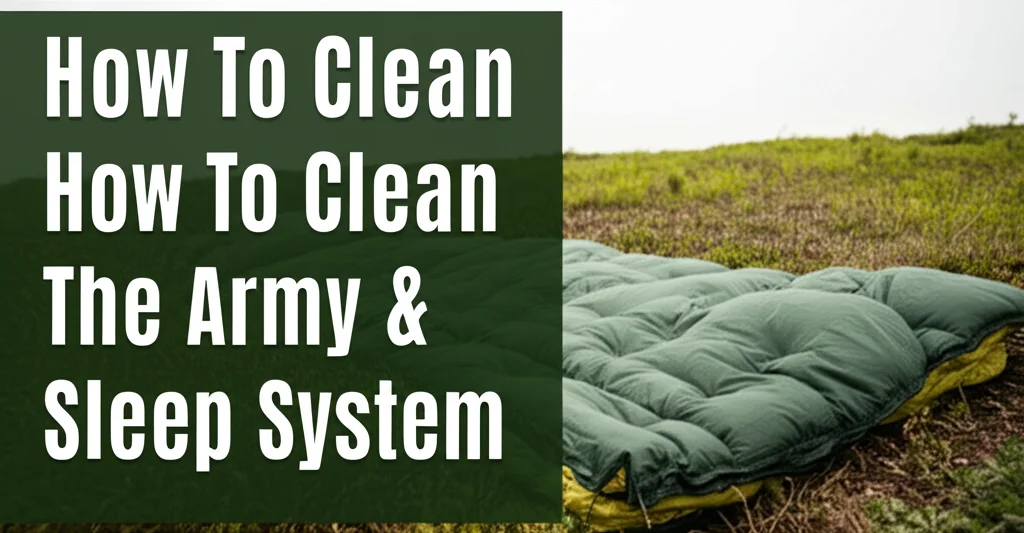· Outdoor & Gear Maintenance · 7 min read
How To Clean The Army Sleep System

Keeping Your Rest Ready: How To Clean The Army Sleep System
Ever wonder how to properly care for the gear that keeps you comfortable in the field? The Army Sleep System is a significant investment, and maintaining its cleanliness is crucial for hygiene, performance, and longevity. A dirty sleep system can harbor bacteria, reduce insulation, and ultimately impact your rest. This article will provide a comprehensive guide on how to clean your Army Sleep System, covering each component and offering practical tips for keeping it in top condition. We’ll break down the process step-by-step, ensuring you can maintain a clean and comfortable sleep environment, no matter where your duties take you. Let’s dive in and learn how to keep your sleep system ready for action!
Quick Answer: To clean the Army Sleep System, disassemble all components. Wash the patrol bag and compression sack in a washing machine on a gentle cycle with mild detergent. Air dry completely. Wipe down the sleep pad with a damp cloth and mild soap, avoiding harsh chemicals. Regularly inspect for damage and repair as needed.
Takeaway:
- Disassemble all components for thorough cleaning.
- Use gentle detergents and avoid harsh chemicals.
- Prioritize complete air drying to prevent mildew.
- Regular inspection and repair extend the system’s life.
Understanding Your Army Sleep System Components
Before we begin, let’s identify the key components of the Army Sleep System. Knowing what you’re dealing with will make the cleaning process much easier. The system typically includes a patrol bag (the outer shell), a liner (often a Spandex or similar material), a compression sack, and a sleep pad. Each component requires a slightly different cleaning approach, so understanding their materials is essential. The patrol bag is designed to withstand harsh conditions, while the liner provides added warmth and hygiene. The compression sack helps reduce bulk for easy transport, and the sleep pad offers insulation and cushioning.
Cleaning the Patrol Bag & Liner
The patrol bag and liner are the most frequently soiled components of the Army Sleep System. They accumulate dirt, sweat, and potentially other contaminants during use. Proper cleaning is vital to maintain their insulating properties and prevent the growth of bacteria. Here’s how to tackle this task:
Washing Machine Method
- Disassembly: Remove the liner from the patrol bag.
- Preparation: Turn both the patrol bag and liner inside out. This helps to loosen and remove dirt from the interior.
- Detergent: Use a mild, liquid detergent specifically designed for synthetic materials. Avoid using bleach or fabric softeners, as these can damage the fabric and reduce its performance.
- Washing Cycle: Wash both items on a gentle cycle with cold water. A delicate cycle minimizes wear and tear on the materials.
- Rinsing: Ensure both items are thoroughly rinsed to remove all traces of detergent. Residual detergent can attract dirt and reduce the bag’s effectiveness.
- Drying: Air dry the patrol bag and liner completely. Avoid using a dryer, as the heat can damage the materials. Lay them flat or hang them in a well-ventilated area, away from direct sunlight.
Cleaning the Compression Sack
The compression sack is often overlooked, but it can harbor dirt and moisture. Keeping it clean helps prevent odors and ensures it functions properly. Cleaning the compression sack is relatively straightforward:
- Empty the Sack: Ensure the compression sack is completely empty.
- Hand Wash: Fill a sink or basin with lukewarm water and add a small amount of mild detergent.
- Gentle Cleaning: Gently wash the sack by hand, paying attention to any soiled areas.
- Rinse Thoroughly: Rinse the sack thoroughly with clean water until all traces of detergent are removed.
- Air Dry: Allow the compression sack to air dry completely before storing it.
Maintaining Your Sleep Pad
The sleep pad provides crucial insulation and comfort. Cleaning it regularly prevents the buildup of dirt and grime. Unlike the fabric components, sleep pads require a more delicate cleaning approach.
Cleaning Procedure
- Wipe Down: Use a damp cloth with a mild soap solution to wipe down the surface of the sleep pad. Avoid using harsh chemicals or abrasive cleaners.
- Inflation/Deflation: Inflate the pad fully and wipe it down, then deflate and repeat. This ensures all surfaces are cleaned.
- Rinse: Use a clean, damp cloth to rinse away any soap residue.
- Air Dry: Allow the sleep pad to air dry completely before storing it. Ensure it’s fully dry to prevent mildew growth.
- Valve Inspection: Regularly inspect the valve for any damage or debris. A malfunctioning valve can affect the pad’s inflation and deflation.
Addressing Stubborn Stains & Odors
Sometimes, despite your best efforts, stubborn stains or odors may linger. Here are a few tips for tackling these issues:
- For Stains: Pre-treat stains with a mild stain remover specifically designed for synthetic fabrics. Apply the remover to the stain, let it sit for a few minutes, and then wash as usual. You can also find specialized gear cleaning solutions designed for outdoor equipment.
- For Odors: If your sleep system has a lingering odor, add a cup of white vinegar to the wash cycle. Vinegar is a natural deodorizer and can help neutralize unpleasant smells. Alternatively, consider using a gear-specific odor eliminator.
- Mold Prevention: If you suspect mold growth, clean the affected area with a diluted bleach solution (1 part bleach to 10 parts water). Be sure to rinse thoroughly and allow the item to air dry completely. If you’re concerned about bleach damaging the fabric, test it on an inconspicuous area first.
Storage Best Practices for Longevity
Proper storage is just as important as cleaning. Storing your Army Sleep System correctly will help maintain its condition and extend its lifespan.
- Complete Drying: Ensure all components are completely dry before storing them. Moisture can lead to mildew and damage the materials.
- Loose Storage: Avoid compressing the sleep system for extended periods. Compression can damage the insulation and reduce its effectiveness.
- Cool, Dry Place: Store the sleep system in a cool, dry place away from direct sunlight and extreme temperatures.
- Ventilation: Ensure the storage area is well-ventilated to prevent moisture buildup.
- Regular Inspection: Periodically inspect the sleep system for any signs of damage or wear and tear. Addressing issues promptly will prevent them from worsening.
FAQ: Your Army Sleep System Cleaning Questions Answered
Q: Can I use bleach on my Army Sleep System? A: Avoid using bleach unless specifically addressing mold. Bleach can damage the fabric and reduce its performance. If you must use bleach, dilute it significantly and test it on an inconspicuous area first.
Q: How often should I clean my Army Sleep System? A: Clean your sleep system after each extended use or when it becomes visibly dirty. Regular cleaning prevents the buildup of dirt, bacteria, and odors.
Q: What type of detergent should I use? A: Use a mild, liquid detergent specifically designed for synthetic materials. Avoid detergents with harsh chemicals, bleach, or fabric softeners.
Q: Can I put my sleep pad in the washing machine? A: No, do not put your sleep pad in the washing machine. It can damage the internal structure. Always clean it by hand with a damp cloth and mild soap.
Conclusion: Rest Easy with a Clean Sleep System
Maintaining a clean Army Sleep System is essential for hygiene, comfort, and longevity. By following the steps outlined in this guide, you can ensure your sleep system remains in top condition, providing you with a restful and reliable sleep environment. Remember to disassemble all components, use gentle detergents, prioritize complete air drying, and store your system properly. Investing a little time in cleaning and maintenance will pay off in the long run, ensuring your sleep system continues to support you on all your missions. Don’t underestimate the importance of a good night’s rest – keep your Army Sleep System clean and ready for action!
- army sleep system
- military gear cleaning
- sleep system maintenance




